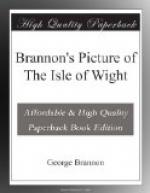The gayest season at Newport is during the Whitsuntide Fair, and three successive Saturdays at Michaelmas, the time when the agricultural servants receive their wages, and re-engage for the following year. The old custom of the female-servants assembling at one part of the town, and the men at another, for the purpose of engaging in new situations, is still partially kept up; these occasions are familiarly called the “Bargain-fair Saturdays,” the middle or principal one falling on the first Saturday in October.
* * * * *
PUBLIC BUILDINGS.
Of these the most conspicuous is the GUILDHALL, situated nearly in the centre of the town: it is rather a stately edifice of the Ionic order. Here the magistrates of the whole island meet every Saturday for hearing and deciding upon petty causes: and examining and committing prisoners to the Winchester assizes, or in, minor offences to take their trials at the quarter sessions for the Isle of Wight, formerly held at Winchester, but which are now very properly adjourned, to save the inhabitants the great inconvenience and expense of crossing the water. There are also the quarter sessions for the borough; and that excellent institution, the County Court for the settlement of small debts.—In the area beneath the hall is held the Saturday’s market for poultry, eggs, and butter.
Another showy building is the ISLE OF WIGHT INSTITUTION, or permanent public Library, to which nearly all the neighbouring gentry subscribe. Besides the reading-room and library it contains a museum for local curiosities, &c. Temporary residents in the island may become subscribers for six months by a payment of 25s.
The FREE-GRAMMAR SCHOOL is the only building claiming respect for its antiquity (besides the parish-church), situated in the street leading to the Cowes road: it was erected by subscription in the year 1619, and duly endowed. Though recently having been repaired throughout, its appearance is still rather picturesque: and possesses considerable historic interest, from the memorable conference held here between the parliamentary commissioners and king Charles the First, up to the unfortunate moment when he was unexpectedly seized and imprisoned in Hurst Castle.
The PARISH-CHURCH is considered to be of the age of Henry II, as it is dedicated to St. Thomas-a-Becket: it is spacious, and has a fine lofty square tower; but there is nothing very particular either in its architecture or antiquities to call for minute description. The chief curiosities are ... the Pulpit, remarkable for its rich and ingenious carving: a monument to Sir Edward Horsey; and the spot where the second daughter of King Charles was buried: she died while the family were prisoners at Carisbrooke—and it was only by accident in the year 1793 that the vault was discovered.—ST. JOHN’S CHURCH, built a few years ago on the south side of the town, at the foot of Montjoy’s, is a conspicuous object in most points of view: and though plain in appearance, is very convenient in its interior arrangements: it is supported on the voluntary principle.




